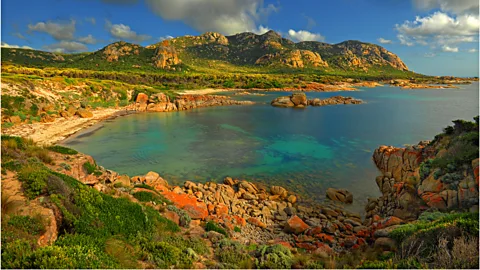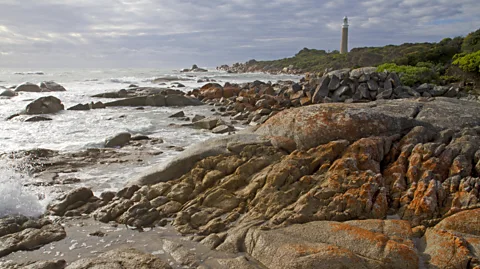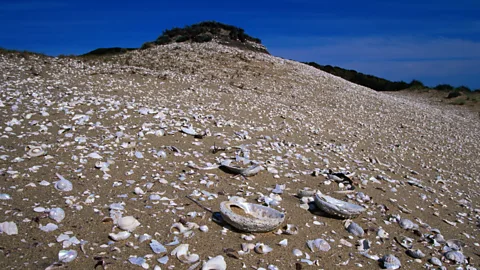The rebirth of Tasmanian indigenous culture
 Southern Lightscapes-Australia/Getty Images
Southern Lightscapes-Australia/Getty ImagesAlthough many people believe that this ancient culture and people were lost, recent years have seen a seismic shift in recognition for indigenous Tasmanians.
Among the sand dunes that line Tasmania's north-east coast, a campfire burns. Carleeta Thomas stands beside the fire, tending the muttonbird that cooks in the flames, surrounded by a series of wooden sleeping pods dotted through the scrub.
The oily muttonbird, or short-tailed shearwater, has been a traditional palawa (Tasmanian Aboriginal) food for as long as anyone knows, and these sleeping pods have been designed to replicate palawa huts found on Tasmania's west coast.
Today, they're an immersive piece of the wukalina Walk, a guided hike along the larapuna/Bay of Fires coast that is the first tourism business owned and operated by the palawa community. They're an expression of an ancient culture and people that even someone as young as 21-year-old Thomas, wukalina Walk's head guide, has often been told was dead.
"When I went to high school, there were still people that were saying 'I swear Truganini was the last Tasmanian Aboriginal'," she said. "I didn't really know how to respond to that. I knew I was Aboriginal."
The myth that Bruny Island woman Truganini was the last Aboriginal Tasmanian has persisted since her death in 1876, less than 80 years after Tasmania was settled by Europeans. In those early decades, palawa suffered a series of atrocities, from being forced into missions by the state's so-called Chief Protector of Aborginals, George Augustus Robinson, to be "civilised and Christianised", to the Black Line of 1830, when settlers formed a moving human chain across the island to try to capture the remaining Aboriginal population. The settlers were outsmarted: only two palawa were reported as captured.
The treatment of the palawa has been described as a genocide, though the lineage survived, with some palawa women taken to Bass Strait islands off the north coast of Tasmania by British and American sealers.
 Andrew Bain
Andrew BainIn the 2016 Australian census, more than 23,000 Tasmanians identified as Aboriginal, representing 4.6% of the population – higher than the national rate, where 3.3% of Australians identified as Aboriginal.
For palawa, there has been a seismic shift in recognition in recent years, with a new embrace of indigenous culture across Tasmania. In 2014, the state began a process of bestowing dual names – English and palawa kani – on places, so that the likes of Mount Wellington, which looms over Hobart, became kunanyi/Mt Wellington; and the Tarkine rainforest in Tasmania's north-west became takayna/Tarkine. With 15 new Aboriginal or dual names approved at the start of this year, there are now 28 altered place names across the state.
The wukalina Walk began in 2018, bringing palawa culture, country, stories and bush tucker to travellers. Tasmanian Aboriginal Studies is now taught in schools, and palawa arts such as shell stringing, weaving and kelp basket-making have come to the fore.
In April 2021, palawa artist Caleb Nichols-Mansell opened the doors of Blackspace Creative, an art gallery in the city of Burnie on Tasmania's north-west coast, now representing 19 palawa artists.
"I say that we're the first dedicated palawa arts and cultural hub," said Nichols-Mansell, who believes the re-emergence of palawa culture to be part of a recent recognition – spurred in a large part by the Black Lives Matter movement – of the state's brutal history.
"I think we've reached a point that we have to acknowledge the history," he added. "We can't move forward any further without acknowledging what happened in the past. I think the reason we've seen such an interest in arts and culture is because that's the easiest angle to approach these things from when we want to talk about truth-telling and reconciliation and acknowledgement of the past. It's easier to do that through artistic and cultural expressions than to approach the monster head-on. I feel like it was a natural progression."
Sheldon Thomas is one palawa artist who's seen the cultural tide turn. In 2007, he was one of four people plucked from an arts course by the Tasmanian Museum and Art Gallery (TMAG) to make the first traditional palawa canoe in almost 170 years.
 Andrew Bain
Andrew BainUsing scans of five small 1840s canoes in the museum's collection, they puzzled together the methods for building a canoe using bark from the native stringybark tree. Their 5.35m-long canoe remains on display in TMAG, and Thomas has gone on to build canoes for the likes of the Maritime Museum of Tasmania, the biannual Wooden Boat Festival and a national-park installation in remote Southwest National Park. He's currently making a canoe for the Australian National Maritime Museum in Sydney.
One of Thomas' canoes has been paddled from Bruny Island to the Tasmanian mainland, and he plans to make a three-day journey from Bruny Island to Hobart in one of the canoes in 2023.
He describes the canoe-making as a revival of one of the world's oldest traditions, a practice going back at least 40,000 years, and something that rescued him from a life of alcohol and obliteration.
You may also be interested in:
• Is this Australia's best-kept secret?
"I wouldn't be standing here, I wouldn't be the person I am today [without it]," he said. "I'm so grateful."
Thomas, who has also revived the painstaking practice of making rope from stringybark (a 20m-length of rope can take four months to make), says the driver for much of the new and visible cultural expression across Tasmania is legacy: the desire to hand down traditions that came so close to being lost.
"I think people in the community are standing up and seeing the big picture for their kids," he said. "What are we going to do for them? I saw my kids and I thought, 'I need to do things for my kids, too.' That's why I want to do the canoes properly.
"I'm also going to teach kids because I'm getting a bit older. I'm going to get about half a dozen kids in the community and teach them how to do it properly."
Teaching has been one of the most significant changes in Tasmania's relationship with its indigenous past. In 2018, Tasmanian Aboriginal Studies was added to the senior secondary school curriculum. Palawa woman Sandra Guerzoni had been advocating for the teaching of local indigenous history and culture in schools since working as a senior curriculum officer in Aboriginal education in the 1990s. Today, she teaches Tasmanian Aboriginal Studies at Hobart's Guilford Young College.
 Oliver Strewe/Getty Images
Oliver Strewe/Getty Images"The thing that's really hard to get across when you're in schools is that this is a living culture," Guerzoni said. "There's contemporary Aboriginal culture – it didn't just die.
"I think kids need to see both sides of the story. It's not about taking land back, it's about delivering a course for the right reasons and looking to unpack what really happened and the repercussions."
It was a change that came too late for the schooling of Carleeta Thomas, but her learning journey goes on. When she started guiding with wukalina Walk in 2018, she knew little about her own culture, despite growing up on Cape Barren Island, where the one township is an Aboriginal community.
In working for wukalina Walk, she says she's rediscovered her connection to the old ways, country and culture. She's sat with the Aunties – the female palawa elders – learning the intricate art of shell stringing, and grown from a shy island child to a confident woman who can express and share her people's living stories to those who want to walk and learn.
"By bringing guests out on country and showing them how much we've been able to keep intact and changing people's views and perceptions of our community, that's one of the most amazing things for me," she said.
"I guess our spirit in lutruwita (Tasmania) has obviously died a little bit because there haven't been constant practices of our culture. And that's heart breaking to me. To be a young community member, to know a little bit of what I know, and to be able to share that with people, that's an amazing feeling."
Travel Journeys is a BBC Travel series that transports you to some of the most breathtaking landscapes, far-flung locations and fascinating cultures on Earth.
--
If you liked this story, sign up for the weekly bbc.com features newsletter called "The Essential List". A handpicked selection of stories from BBC Future, Culture, Worklife and Travel, delivered to your inbox every Friday.
{"image":{"pid":""}}
